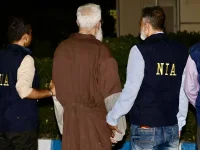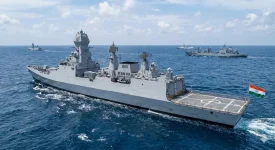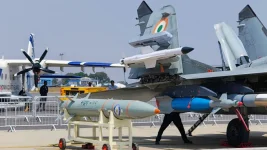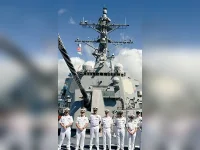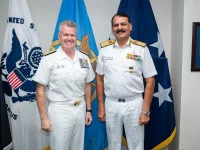- Views: 128
- Replies: 7
The future of the Indian Navy’s premier aircraft carrier, INS Vikramaditya, appears increasingly uncertain. Naval sources indicate that the 45,000-tonne vessel, which has served as the cornerstone of India’s maritime power since its commissioning in 2013, may face retirement as early as 2037.
This potential decommissioning depends on the results of a critical structural audit scheduled for 2035, which will determine if the Soviet-era hull can safely endure another 15 years of active service.
The Looming Structural Assessment
The decision to extend the carrier's life to 2052 rests on a comprehensive technical evaluation. While the ship underwent a massive $2.35 billion refurbishment before joining the Indian fleet, the core hull dates back to 1982.Experts warn that despite extensive modernization of its systems, the steel structure remains a "Soviet relic" susceptible to metal fatigue and corrosion, particularly in the warm, saline waters of the Indian Ocean.
The 2035 audit will likely employ advanced non-destructive testing methods. This includes ultrasonic hull scanning and AI-driven fatigue modelling—a technology increasingly adopted by modern navies to create "digital twins" of ageing ships.
These digital models simulate stress points and predict structural failures before they occur, allowing engineers to calculate the precise risks of extending the vessel's lifespan.
Economic and Strategic Dilemmas
The financial implications of keeping INS Vikramaditya operational are stark. A projected mid-life upgrade (MLU) could involve costs comparable to building a brand-new vesselEstimates for a 2025 refit alone stand at approximately ₹1,207 crore ($145 million) for basic avionics and sensor updates. However, a full life-extension program—requiring deep hull strengthening, steel renewal, and propulsion modernization—could cost three times that amount.
Sources suggest that if the structural integrity is found wanting, the investment would be economically unviable. "In ten years, we will assess if the ship can be upgraded in India. If the costs eclipse the price of a new build, we may have to retire her," a defence official noted.
This reality places pressure on the Navy's long-term planning, specifically regarding the proposed Indigenous Aircraft Carrier-2 (IAC-2). Facing budget constraints and urgent timelines, the Navy is reportedly pivoting from a larger 65,000-tonne "supercarrier" design to a repeat order of the Vikrant-class carrier to ensure no capability gap emerges when Vikramaditya retires.
A Troubled Legacy: The Kiev-Class Curse
INS Vikramaditya belongs to the Soviet Kiev-class of "heavy aviation cruisers," a lineage notorious for short operational lives and structural deficiencies.- INS Vikramaditya (ex-Baku/Admiral Gorshkov): The only operational survivor of the class. It suffered repeated boiler failures during sea trials in 2012 due to faulty thermal insulation and has experienced fire incidents during its Indian service.
- Kiev & Minsk: Both were decommissioned prematurely in 1993 after less than 20 years of service. They were sold to China to become theme parks. Notably, the Minsk was recently severely damaged by a massive fire in August 2024 while awaiting renovation.
- Novorossiysk: Scrapped in 1997 after suffering a major engine room fire, serving for only roughly 11 years.
Unlike US Navy supercarriers like the USS Nimitz, which was designed for a 50-year service life, the Kiev-class hulls were not built with such longevity in mind.
Operational History
Originally commissioned into the Soviet Navy in 1987 as Admiral Gorshkov, the ship served as a Cold War flagship before being mothballed in 1996 due to Russia's post-Soviet financial crisis.India acquired the vessel in 2004, initiating a protracted and expensive conversion from a hybrid cruiser-carrier to a pure Short Take-Off But Arrested Recovery (STOBAR) carrier.
Since its Indian commissioning in 2013, Vikramaditya has logged over 100,000 nautical miles, proving its worth in major exercises like Malabar and conducting patrols during tensions along the Line of Actual Control (LAC).
However, as it approaches its 43rd year since launch, the physical limits of its Cold War-era design are becoming impossible to ignore.
Key Timeline: The Path to 2037
| Year | Event | Details |
|---|---|---|
| 1979–1982 | Construction | Laid down as Baku at Mykolaiv Shipyard, Ukraine. |
| 1987 | Soviet Service | Commissioned as Admiral Gorshkov; served in the Northern Fleet. |
| 1996 | Decommissioning | Mothballed by Russia following the Soviet collapse. |
| 2004 | India Deal | India signs $1.5 billion refit deal; project plagued by delays. |
| 2013 | Indian Induction | Commissioned as INS Vikramaditya on 16 November. |
| 2025 | Interim Refit | Estimated ₹1,207 crore upgrade for sensors and avionics. |
| 2035 | Critical Audit | Structural assessment to decide on life extension to 2052. |
| 2037 | Potential Retirement | Likely decommissioning date if structural audit fails. |


